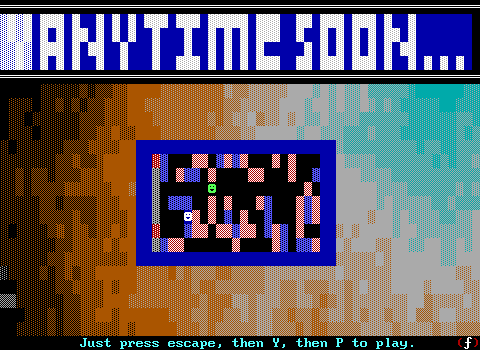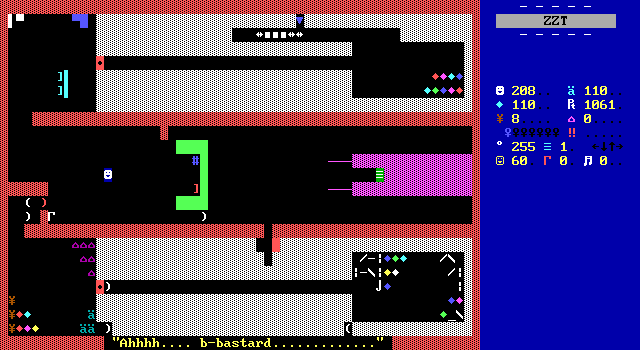This article's world comes from an urge to play something a little older. This late into the year, and only four worlds played have been devoid of STK graphics, so I wanted to get back to the basics with something sufficiently old-fashioned. The trouble is, these very early worlds often seem better suited for streaming than articles, rarely having too much depth to them. So I was rather pleasantly surprised when I stumbled across The Search for the Ancient, a world of unknown age that certainly looks and feels very early (with some other moments that make a 1992-ish release seem accurate enough).
These worlds usually are only a few steps removed from Town of ZZT at most. Though the macguffin items for players to grab are probably something more flavored to the world than simply purple keys, the structure usually isn't that far off. Weird worlds with perfectly normal (if brightly painted) buildings to enter, only for their innards to contain lord knows what. That photography studio is equally parts likely to contain a friendly man selling film as it is a zoo's worth of animals. Sometimes though, that's exactly what you want out of these games. Early ZZT worlds are known for their surprises, with few conventions established for what authors should and shouldn't do.
The Search for the Ancient manages to dabble in a little bit of everything for the era, neatly dividing itself into two halves with very different approaches as to how best keep players entertained. It's also got a unique story to get the game underway, where your assumptions before playing are likely going to be discarded almost immediately. In the end, the game manages to do a little bit of everything it seems, and it does so with complete confidence in its execution. Author John Hoelle never needs to stop things to provide the player with instructions, never needs to slap "SAVE SAVE SAVE" across his boards, and never needs players to second guess themselves. It's an impressive title from the early days of ZZT that I was pleased to find is still a rather fun time even now.

No Place Like Home

An opening scroll greets players upon starting the game to clue them in on who they are and what they've been doing. Your character is nameless, a soldier that has returned home from the Great War of 31,289 AD. It's been a truly terrible war that the intro describes as a "26-year slaughter".
The enemy goes unstated, and while the game takes place in the far future where humanity has settled across multiple galaxies, no mention is ever made of other species. It's very likely that man is still taking up arms against his fellow man here.

The opening board is a bit on the empty side, some forest in corner and a temple in another. The pre-STK graphics make a lot of boards a stark black color that works quite well with the theme of humanity on the brink of their own destruction. It's a bleak atmosphere, one even commented on by the protagonist. Rumor has it that very few humans are still alive after this war. Contact with other humans, even on your home planet, is now a rarity.
While there's no clear date on when this game was released, the format the game takes makes it almost certainly skew early. The only other release credited to Hoelle (as well as Highway Warrior Productions) is dated January 1992. Both games have their title screen board named "Introduction Screen", used only in the original ZZT v2.0 release, so I suspect this one is also a 1992 game as well, give or take.
Regardless of precisely when the game came out, it's remarkably dark for a game of its vintage. Early ZZT worlds had their share of horror with Adam Rixey's The Crypt having gory descriptions of death and demonic sacrifices as its claim to fame. This game however, relies more on being unsettling in the background, turning the lack of life found on the planet into a constant reminder that it's not supposed to be like this. Doing so works well for the eerie atmosphere now, and the stark contrast later on when players find themselves in a place bustling with life.
The one obvious landmark is the pyramid that the player begins outside of. This place is a holy temple with an oracle that reveals your actual goal for the game. Humanity is on the brink of extinction, and has little drive to carry on. Something needs to be done to revitalize the human spirit lest it fade away into nothing.

This requires a return to "The Ancient". (Hence the title.) A term that when one hears in a video game likely conjures imagery of Final Fantasy and other RPGs, historic peoples that died out long ago who lived in harmony, or perhaps a utopia that was lost to time. The game's title and opening screen made me assume this was what I'd be after, but it's easy to forget just how far in the future this game takes place when one thinks of something being ancient.
"The Ancient" is a nickname given to the planet of humanity's origin, Earth. Today, nobody alive has ever been to the planet. The Oracle decrees the player must travel to Earth, learn the secrets of mankind's origins, specifically the meaning of life, and return with this knowledge so humanity can remember its purpose and fulfill it once more.
It's a task easier said than done. The only way to return to Earth is to make use of a holy transporter that can send one back. Your immediately goal then is to find the key to the temple containing the transporter, activate it, and return to Earth.
Five purple keys this ain't. Merely getting to Earth is only the first part of a long journey, and one that has a significant surprise in store for those who manage to get there.
Hoelle manages to make things very serious, a sharp contrast to the general goofiness expected of early ZZT games. Yet, while the writing takes things in a direction I'd sooner associate with the teenage dramas of the late 1990s. A struggling species ravaged by war checks in closer to titles including Chrono Wars , War-Torn, or Compound than its more likely contemporaries of The Lost Monkeys and Smiley Guy.
The Planet Northside
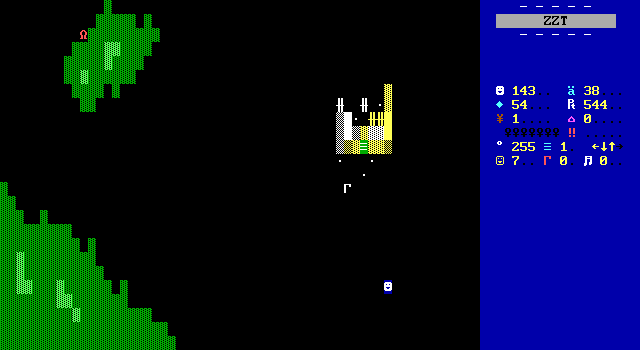
For the first part of the game, players get a fairly traditional open-ended adventure. Northside's surface is freely explorable, and nothing stops players from ignoring the temple they start outside completely, truly wandering aimlessly.
This is at least somewhat discouraged by the fact that the chosen soldier here has no ammunition. While you can wander anywhere you please, doing so without ammo feels like you're doing something wrong. Even so, the war seems to have done a number not just on the human population, but that of the local fauna as well.
The overworld has some enemies to deal with on every board, but their numbers are incredibly small. No ammo would be a hindrance were it not for the surrounding boards being so vast and sparsely populated. Simply avoiding them is easy enough, save for awkward moments of re-entering a board from a different angle and running smack into the middle of some creatures you left in the dust previously.
What players are better off doing, and Hoelle would prefer they do as well, as enter the temple and explore the tomb beneath it to pick up a small supply of ammo and gems to help grease the wheels on this adventure.
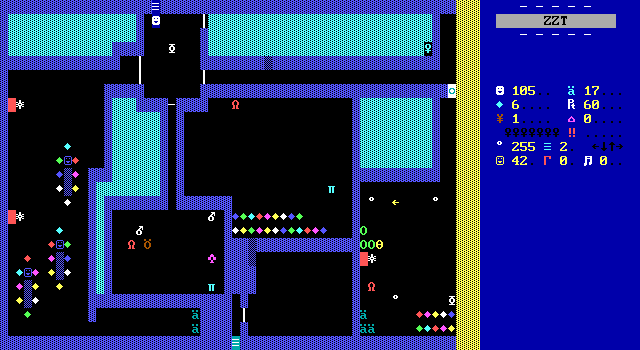
Nothing is free however, the tomb itself has its share of enemies in slightly larger number than the overworld. Given the assumption that players will enter the pyramid with no ammo, and enter the tomb with twenty if they can solve a straightforward "find the fake wall" puzzle", the enemy distribution feels solid.
It also gives a nice glimpse into what Hoelle can do with action scenes to surprise players. The built-ins are the main focus, but the leftmost chamber which appears to be free of danger isn't necessarily so. The gems surround a few tombs for players to read, each with a different description. The first casket gets touched to learn what happens. The second casket gets touched to see if they all produce the same message. The third casket gets touched because players expect another new message.
You can only disturb the dead so much though. That last casket causes the ghost of an ancient pharaoh to appear. ...Which disappointingly only means the object turns into a lion rather than a unique object-based enemy.
The rest of the tomb is fairly no-frills, arguable a gentle tutorial to basic ZZT elements as players travel through transporters, spot fake walls, navigate a very tiny invisible maze, detonate bombs, and burn themselves on still-lit torches.
Once players (hopefully) make their way through the temple and learn what they're actually supposed to be doing, both short-term and long, the world is open for exploration.
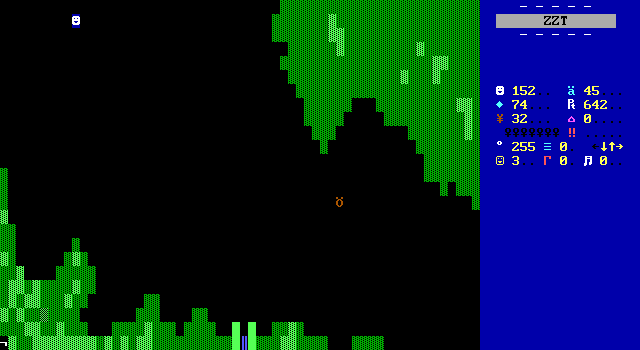
As far as ZZT overworlds go though, there isn't much to take in. A forest makes up the center, with empty looking boards like this one surrounding it where the only signs of life come in the form of hostile creatures.
Not to say that there's no effort in the design, Hoelle includes some ruined buildings, a shop, and some "private property" that clumsily kills players for not abiding by the sign. It's the early 90s, and this sort of thing isn't yet regarded as needlessly-hostile design.

The temple players need to find the key for can be found to the north, and is a personal favorite board of mine. For a game so drab, (without STK for dark colors even!) the little bits of color in the boulders make an impressive sight. Hoelle uses this board as a good opportunity to establish the world the player is currently wandering, with a sign explaining that this is the Holy Lake Ghrist, where the boulders are said to be hardened tears of the gods.
This turns an already nice looking board into a special place. One can imagine a lake surrounded by oddly bright-colored rocks in real life attaining some historic significance.
It even doubles as a puzzle once players realize that the door they need to unlock is the second barrier towards getting inside the temple. First a wall must be lowered, which can be done by finding a specific boulder that can't be moved which lowers the wall when touched.
It's maybe not the most exciting puzzle, just a guessing game, but the medium used has some advantages. Usually these hidden switch (or gem) hunts force players to tediously touch every single object and wall they can find. Here in a pre-STK world, the blinking water can immediately be disregarded as a possible hiding place. More importantly, the ability to push multiple boulders at once means players can feel free to hold down a button and push a line of boulders all at once, removing them from the list of possibilities faster than they would if they were un-pushable objects. If your pushing comes to an unexpected halt, you know you've struck something.
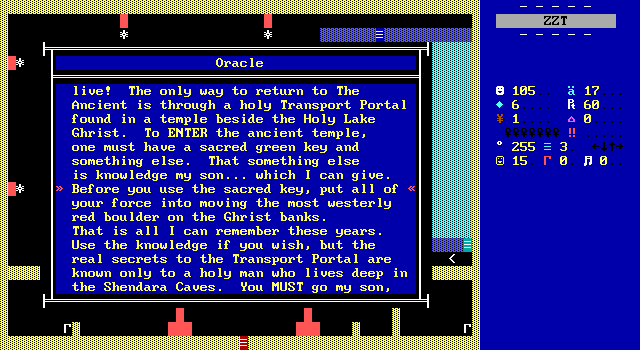
...Scratch that. I mean, it applies yeah, but only on the final pass for this article did I realize that the oracle explicitly tells players which boulder to push.
Listen. There's a lot of words in there and you only get to see them once.
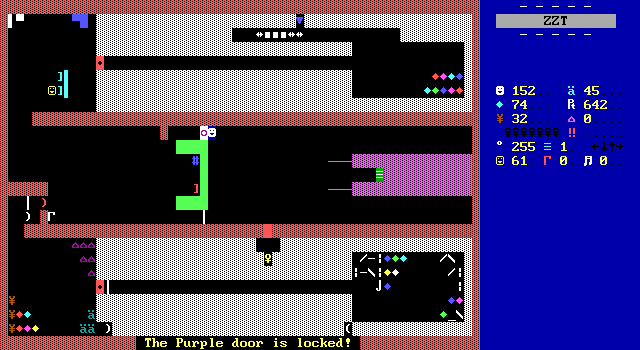
The game's trading outpost is rather impressive as well. It's a very elaborate shop taking up the entire board, a sharp contrast to the more minimalist designs seen in later worlds. Touching the green counter summons the proprietor that sells not just standard ZZT supplies, but a few more unique items.
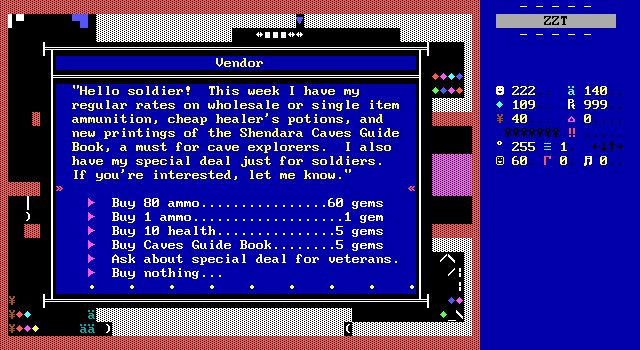
The prices are rather bizarre, swinging to extremes with ammo available in two sizes: one and eighty.
The guide to the caves provides players with some important clues in order to actually progress through the game. It hints to all potential spelunkers that there may be long blocked off passageways to the north, and it also mentions that the famous King Ramises I dropped his keys to his treasure vault inside. The keys have yet to be found, and the vault unopened, making it a popular spot for adventurers such as the player to explore at the hopes of getting rich.
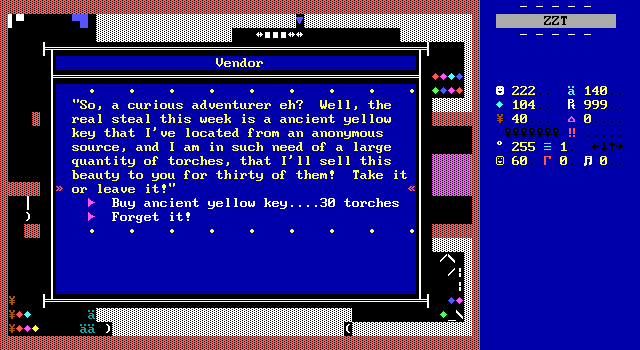
One seeming oversight in the lack of available torches for sale despite the numerous dark caves. It all starts making sense once players ask about the special deal. Torches are used as an alternate currency in this transaction to buy a yellow key. This shopkeeper will only buy the torches he desperately needs from veterans.
Torches are in surprisingly limited supply in this game. An abandoned building has a huge cache which needs to be claimed in order to make this purchase, but I'm not as confident as Hoelle that players will have thirty to spare. Wasting a little time exploring the caves without knowing about the secret passages or how to find the lost keys combined with some slightly slow play there and in other dark areas, and you may genuinely run out.
I found the large cache before visiting the shop and my reaction to it was that my torch troubles were over then, only to later realize I had to part with most of them, leaving myself just optimistic enough that I'd be able to get by with what remained.
Purchasing the yellow key eventually ends up netting the player several others. This includes a purple one used to unlock access to the backrooms, where the merchant warns players that if they touch anything back here, they'll call the police.
It's a bluff thankfully, though the player's morals keep them from raiding the cash register at least. The rest of the building is surprisingly fair game if you can defeat the amusingly elaborate security measures Hoelle devised, that is.
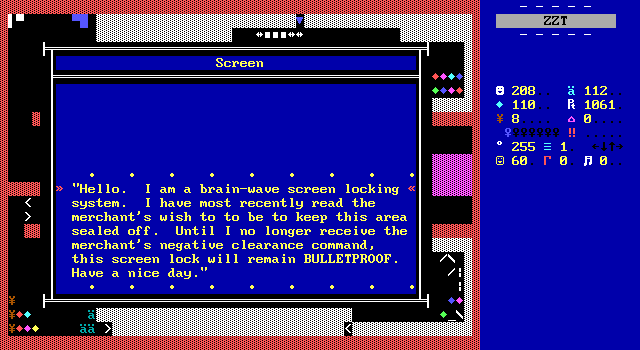
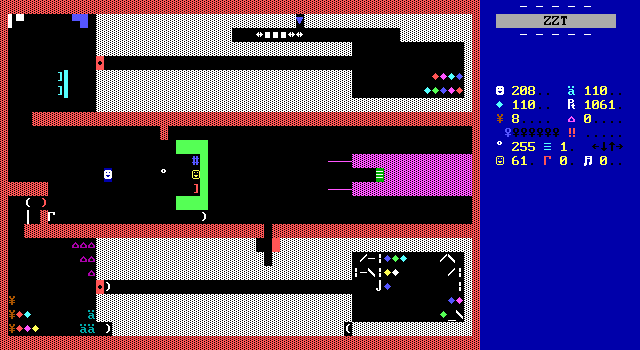
I don't know what it is about old ZZT games that seem to love letting players kill friendly NPCs for little, or even no benefit. Killing the shopkeeper allows you to shoot the no longer bulletproof wall and grab some items for yourself. If you head deep enough inside, you'll wind up in a spiderweb-laden vault and have to fight a spider enemy to escape its clutches.
None of it matters at all! Players can skip the murder and the supplies and do just fine. It all seems to be for the sake of keeping you busy with things to interact with and collect.
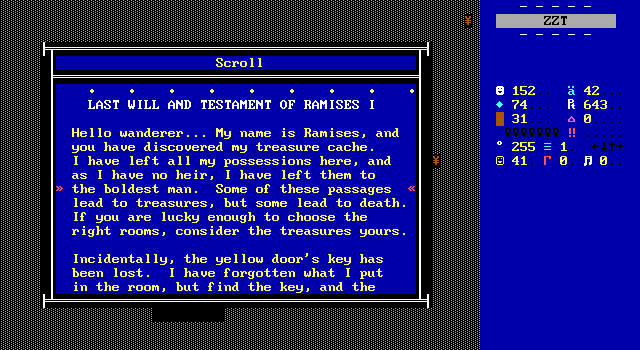
King Ramises's treasure chamber can be found in the center of the forest where the king has decreed that anyone bold enough to risk their lives for his treasures may keep whatever they manage to gain hold of.
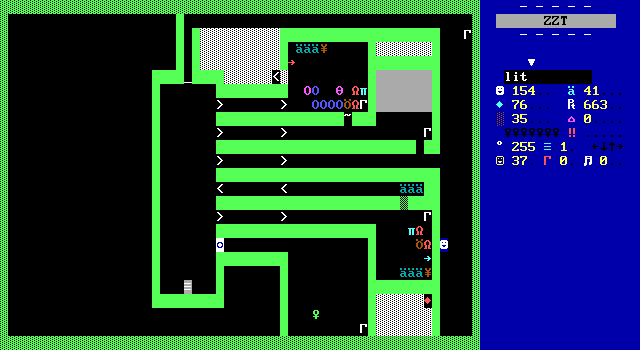
It's another basic action board with some added risk. In darkness, players can only see a few transporters that will trap them on the other side, with no hints as to what may lie on the other side.
Despite Hoelle being fine with killing players for going into a building they weren't supposed to, this board actually defies the instant game over trope. Players have no way of knowing that the game is lying to them, resulting in a great board that feels tense with every transporter entered.
The lit up layout makes it clear that the transporters are really just leading players into rooms with a good amount of monsters and some treasure, with exits always available regardless of which routes players try.
The locked door that requires the lost keys of Ramises is also carefully designed so as not to spoil what's inside from the adjacent chamber. Players have no way of knowing the green key to the temple that they seek is in here until they're able to grab it.
I've definitely commented on streams a number of times that I often wished Tim Sweeney had made keys visible in darkness, to make it easier to guide players to them, but this is a solid case against that. Of course, you could just hide the key in a treasure chest object, but I'm willing to admit that there are times like this where ZZT's actual behavior is an advantage rather than detriment.
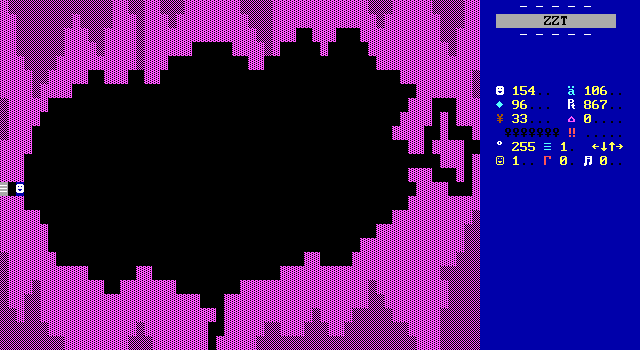
To actually make progress, players need to thoroughly explore the Shendara caves in the southeast corner of the map. Practically speaking, this means players are told about the suspected passages to north as well as learning to shoot the eastern walls in a later board to find Ramises's missing keys.
My first venture in the caves, I did notice there was a board to the north thanks to SolidHUD, and was worried this would be another situation like The Lost Pyramid where players needed to realize that the ability to shoot the shading wasn't an oversight, but a requirement to get through the game. Needless to say, I was relieved when I later found the hint in the shop that spells it out.
Coming across this kind of hidden path a second time, now with a hint, made me appreciate it more. Both The Search for the Ancient and The Lost Pyramid are some very early titles where even the idea of "shading" was still rather unique (and limited, as colored water couldn't be produced in ZZT's editor, though it can be produced via code). As STK proliferated and shading become more of an expectation, the innate properties of breakable walls and water were written off as quirks of ZZT that ideally one would prevent by being careful about placement or using objects along edges.
But this is from long before that! These games intend for players to realize they can shoot away the walls and reward them for doing so rather than leaving boards looking messy. Complaining about this would be like complaining that the game was using fake walls as walls which are fake rather than as colored floors. Breakable walls are intended to be shot, not to make gradients. I'm beginning to feel that I was being unfair towards Lost Pyramid for not meeting expectations that wouldn't be expectations until well after the game's release.

The cave feels rather different as well since both of the player's goals are hidden away. It's very much possible to go inside and leave with nothing more than some supplies. Depending on when players first enter, they may very well think that's the entire point.
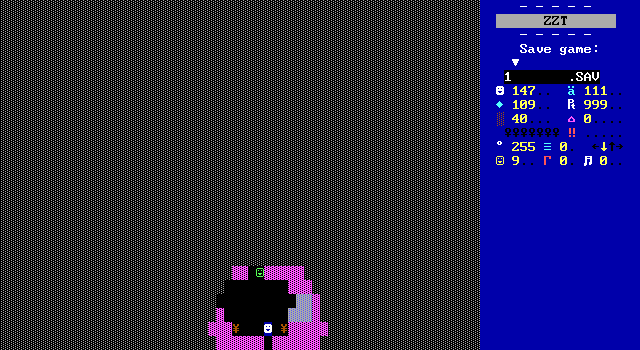
The first hidden path reveals a sage who has been living on cave mice and a natural spring for fifty years awaiting the fulfillment of a prophecy where he can help a soldier out. To do this though, the player needs to prove that they are the specific soldier by answering a riddle to prove their intelligence.
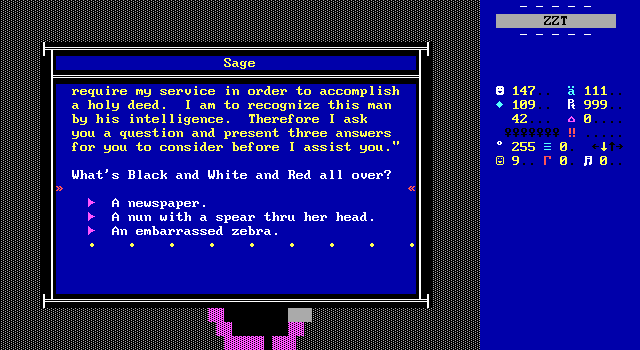
Okay, basic "riddle". Clearly this is more an opportunity for Hoelle to be silly than a real challenge. Maybe the middle answer is a bit more wild than anything I've heard for that one, but hey, it certainly counts.
Answering incorrectly though, is surprisingly hostile towards the player. Going with the newspaper response, which given that the text is written "red" and not "read", is definitely wrong, results in the game calling the player the r-slur for their troubles.
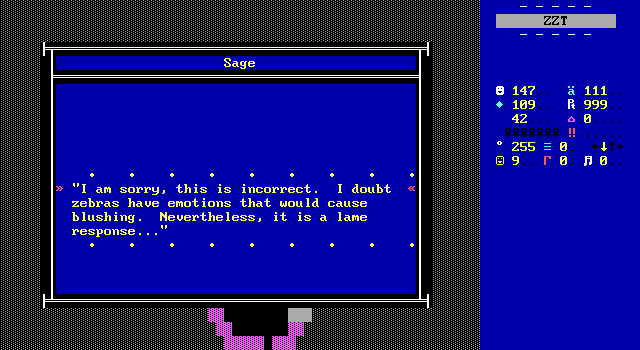
As for zebras, they don't have emotions that would cause blushing. This guy can stay in his cave for another fifty years IMO.
These wrong answers don't penalize the player other than emotionally, so you're safe to land on the answer Hoelle wants of a dead nun. However, some unused code in the object implies this wasn't always the case. A second :touch label that can never be reached holds additional text telling the player that they are not the chosen one and asking them to leave at once.
The whole sequence, though over and done with almost immediately, winds up being brought up again later in the game, as a nice way of demonstrating how the present world differs from the ancient.
Once the riddle is correctly answered, the sage will tell the player everything they know.
This includes critical information on how to activate the Great Transporter in the temple without being destroyed in the process, as well as providing a clue for which of the nine passages within the machine to enter. Each one represents one of the original nine planets humanity built settlements on. This is done in a considerably longer wall of text with its share of explaining that the message is not the message of the sage, but of capital-G God himself.
There's just something about these early ZZT worlds and including just a touch of religion.
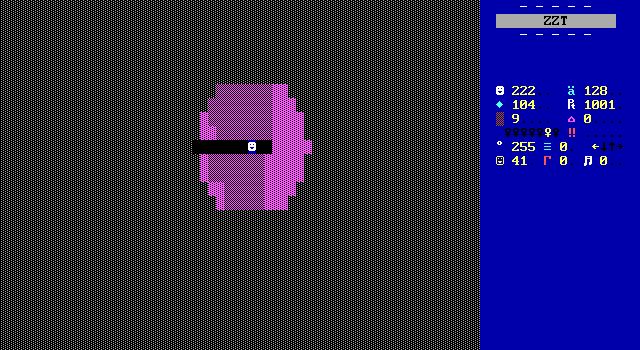
Besides the sage, players exploring the cave are also looking for the dropped keys of old. These are more well hidden, still employing the need to shoot away breakable walls, but surrounding them with some objects disguised as normal walls that also vanish when shot. The hint in the cave guide to shoot the eastern wall is effectively mandatory here, as there are no enemies on the board for players to shoot at and stumble upon the hidden path forward.
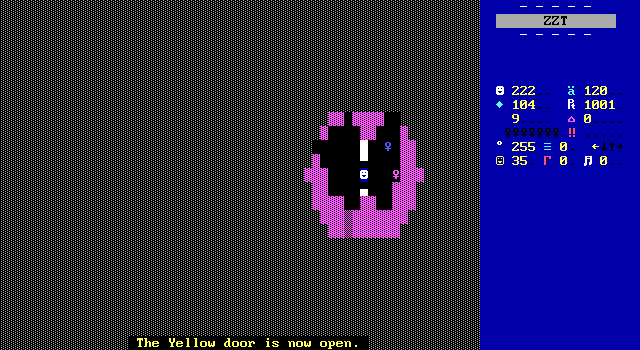
Ramises dropped not one, but two keys. One for the store of all things, and the other for the vault. With these, players can wrap up any unfinished business they have on the planet and head to the Ancient.

The temple has been built up quite a bit over the course of the game so far, so getting inside is an exciting moment. There's a parallel here to be drawn to Town's own palace, which players are constantly made aware of, but will have quite a time in managing to get inside.
What wonders can be found within the temple? Well, nothing much really. Some more colorful crosses which are mostly novel for the fact that speaking to the wrong one (or failing to heed the sage's instructions for how to properly speak to them) doesn't merely kill the player, but kills them in different ways.
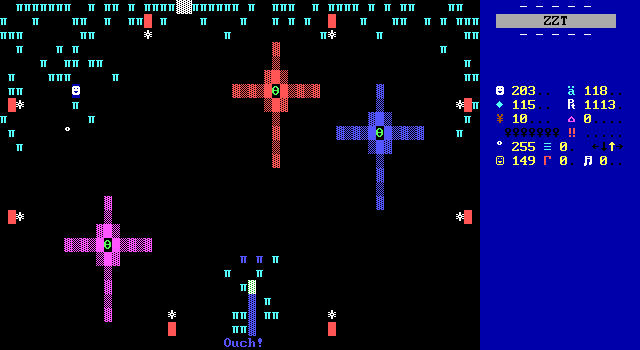
One goes for the classic "wall are now tigers" move.
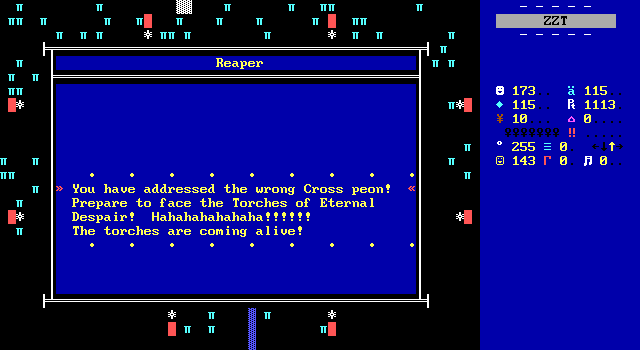
Another causes the torches on the walls to begin moving and endlessly throwing stars.

The last one replaces all the empty tiles with invisibles, then destroys itself and has the core throw stars directly into the player's face.
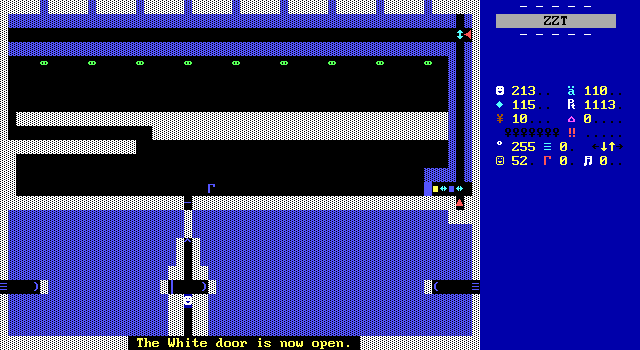
The transporter itself isn't all that impressive a sight to behold. A row of nine statues are presented. The first statue the player touches activates the transporter, clearing open a path to the northern board which consists of a dark room with a series of passages.
Each one represents the nine planets of our solar system (pre-2006) and is unlabeled, requiring the player to make the connection that if they want to travel to Earth, they're looking for door number three.
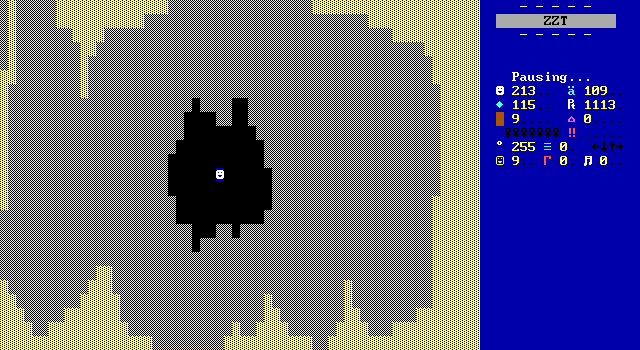
Hoelle is quite committed to creative game overs in The Search for the Ancient, and so the game includes eight unique boards for choosing the wrong planet.
A sign in the transporter room warns travelers that while they can specify where they travel, there's no guarantee of when they'll emerge. So although the backstory informs players that all these planets were colonized at some point, more often than not the player gets to die on a then-lifeless world.
It's honestly quite worth it to sample them all in the file viewer using the stats panel to read the text. Neptune and Pluto are definitely the highlights.
But the fact that each one of these has a unique board attempting to portray each planet with nothing more than the stock ZZT colors is really quite a sight to behold. I'm surprised Hoelle didn't create a more sci-fi game either with this one or a different release.

